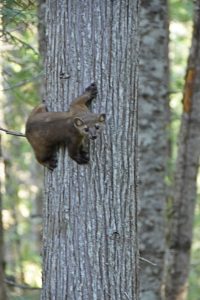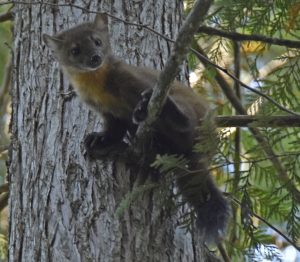(Martes americana)

Physical Characteristics: 19 – 26 inches long, 1 – 3 lbs. Long, slender-bodied weasel with short limbs, bushy tail and silky coat ranging in color from pale yellow to dark brown with a breast spot of varied shade. Roughly triangular head; usually lighter coloring than the body. Sharp nose and relatively large, rounded ears. Furry feet equipped with strong, non-retractable claws. Males 15 – 20% larger than females.
Diet: Agile, opportunistic hunter, seeking prey in trees and on forest floor. Voles comprise majority of diet; also look for other small mammals, bird eggs/chicks, insects, carrion, squirrels, fruit, nuts, and seeds.
Habitat: Prefers mature (particularly coniferous/mixed), forests which contain numerous dead trunks, branches, and leaves to provide cover for prey (rodents). Variety of structures used for denning, including branches, cavities, or broken tops of live trees, snags, stumps, log piles, rock piles, and red squirrel nests. Does not occupy recently burned or cut-over (logging) areas. Relies on snow for thermal protection and opportunities for foraging/ resting. May travel extensively under snowpack.
Range: Coincides mostly with distribution of boreal/montane coniferous forests across North America – Alaska, Canada, Pacific Northwest, Rocky Mountains, Sierra Nevada, Midwest and northern New England. Currently re-establishing where mature forests have returned (previously logged/burned). Individual territory ranges 0.04 – 6.1 square miles. Within the North American range, there are two recognized clades or groups of martens. Recent research indicates these may in fact be two separate species, Martes americana, the American marten, and Martes caurina, the Pacific marten. Interestingly, the ranges of the two overlap in this region, according to one study.
Reproduction: Reach sexual maturity 2 – 3 years old. Breed July – August; give birth to 1 – 6 kits the following March – April. Within three months young reach adult body weight; will leave mother to establish individual home range. May live up to 14 years. Population fluctuates cyclically; attributed to changes in prey abundance and possibly migration. Populations in the Clearwater Basin are not monitored well. Adults are generally solitary outside of breeding season and polygamous during it.

Threats: Trapping greatly reduced populations; still allowed in all but a few states; may account for up to 90% of mortality in some areas, impacting population density, sex ratios, and age structure. Martens are vulnerable to raptors and other carnivores. Reintroduction in areas has allowed numbers to recover; deforestation remains a serious/persistent threat. Research shows martens depend on older, mature forests, the forests most threatened by Forest Service logging proposals. Martens are currently not considered scarce in the Clearwater region by the Forest Service or Idaho Department of Fish and Game. However there is little hard data, other than trapping records, regarding martens in the region.
Miscellaneous: Seeds (they eat) are dispersed throughout forest by way of feces. Presence of Marten is indicator of good environmental conditions because dependent on prey found in mature coniferous forests. Smaller cousin of Northern Rockies Fisher; occupies slightly higher elevations than Fisher.
Return to main Native Species page.